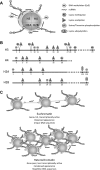Epigenetic alterations in aging
- PMID: 20448029
- PMCID: PMC2928596
- DOI: 10.1152/japplphysiol.00238.2010
Epigenetic alterations in aging
Abstract
Aging is a multifaceted process characterized by genetic and epigenetic changes in the genome. The genetic component of aging received initially all of the attention. Telomere attrition and accumulation of mutations due to a progressive deficiency in the repair of DNA damage with age remain leading causes of genomic instability. However, epigenetic mechanisms have now emerged as key contributors to the alterations of genome structure and function that accompany aging. The three pillars of epigenetic regulation are DNA methylation, histone modifications, and noncoding RNA species. Alterations of these epigenetic mechanisms affect the vast majority of nuclear processes, including gene transcription and silencing, DNA replication and repair, cell cycle progression, and telomere and centromere structure and function. Here, we summarize the lines of evidence indicating that these epigenetic defects might represent a major factor in the pathophysiology of aging and aging-related diseases, especially cancer.
Figures





Similar articles
-
Epigenetic Modifications in Cardiovascular Aging and Diseases.Circ Res. 2018 Sep 14;123(7):773-786. doi: 10.1161/CIRCRESAHA.118.312497. Circ Res. 2018. PMID: 30355081 Review.
-
Epigenetics and genome stability.Mamm Genome. 2020 Jun;31(5-6):181-195. doi: 10.1007/s00335-020-09836-2. Epub 2020 Apr 15. Mamm Genome. 2020. PMID: 32296924 Review.
-
The Aging Epigenome.Mol Cell. 2016 Jun 2;62(5):728-44. doi: 10.1016/j.molcel.2016.05.013. Mol Cell. 2016. PMID: 27259204 Free PMC article. Review.
-
Involvement of noncoding RNAs in epigenetic modifications of esophageal cancer.Biomed Pharmacother. 2019 Sep;117:109192. doi: 10.1016/j.biopha.2019.109192. Epub 2019 Jul 11. Biomed Pharmacother. 2019. PMID: 31387188 Review.
-
Epigenetic modifications and noncoding RNAs in cardiac hypertrophy and failure.Nat Rev Cardiol. 2015 Aug;12(8):488-97. doi: 10.1038/nrcardio.2015.71. Epub 2015 May 12. Nat Rev Cardiol. 2015. PMID: 25962978 Review.
Cited by
-
Haematopoietic ageing through the lens of single-cell technologies.Dis Model Mech. 2021 Jan 22;14(1):dmm047340. doi: 10.1242/dmm.047340. Dis Model Mech. 2021. PMID: 33735102 Free PMC article. Review.
-
Targeting the epigenetically older individuals for geroprotective trials: the use of DNA methylation clocks.Biogerontology. 2024 Jun;25(3):423-431. doi: 10.1007/s10522-023-10077-4. Epub 2023 Nov 16. Biogerontology. 2024. PMID: 37968337 Review.
-
Association of Promoter Methylation and Expression of Inflammatory Genes IL-6 and TNF-α with the Risk of Coronary Artery Disease in Diabetic and Obese Subjects among Asian Indians.Indian J Clin Biochem. 2022 Jan;37(1):29-39. doi: 10.1007/s12291-020-00932-3. Epub 2020 Nov 16. Indian J Clin Biochem. 2022. PMID: 35125691 Free PMC article.
-
Histone Acetylation Dynamics during In Vivo and In Vitro Oocyte Aging in Common Carp Cyprinus carpio.Int J Mol Sci. 2021 Jun 3;22(11):6036. doi: 10.3390/ijms22116036. Int J Mol Sci. 2021. PMID: 34204879 Free PMC article.
-
MBD-seq as a cost-effective approach for methylome-wide association studies: demonstration in 1500 case--control samples.Epigenomics. 2012 Dec;4(6):605-21. doi: 10.2217/epi.12.59. Epigenomics. 2012. PMID: 23244307 Free PMC article.
References
-
- Ahuja N, Li Q, Mohan AL, Baylin SB, Issa JP. Aging and DNA methylation in colorectal mucosa and cancer. Cancer Res 58: 5489–5494, 1998 - PubMed
-
- Aravin AA, Sachidanandam R, Girard A, Fejes-Toth K, Hannon GJ. Developmentally regulated piRNA clusters implicate MILI in transposon control. Science 316: 744–747, 2007 - PubMed
-
- Ballestar E, Esteller M. Methyl-CpG-binding proteins in cancer: blaming the DNA methylation messenger. Biochem Cell Biol 83: 374–384, 2005 - PubMed
Publication types
MeSH terms
Substances
LinkOut - more resources
Full Text Sources
Other Literature Sources
Medical

